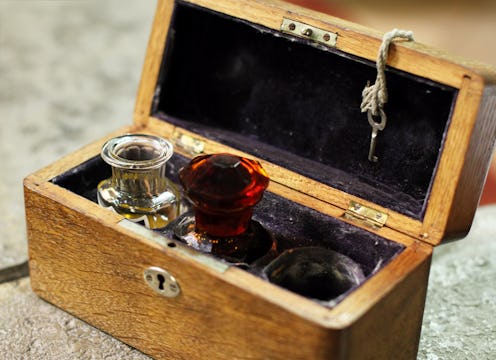
No one can say I'm not making an attempt to be festive this holiday season. Typically, I put on my Grinch hat and hold my breath for the painfully repetitive holiday music, the angry mobs of shoppers that have lost their manners to the holidays, and wait patiently for the ring of the new year to make everything better. My new recent obsession with pure frankincense came just in time for the holiday season, and I wanted to know what other oils in Christmas tales might give me a prettier face. Turns out, myrrh essential oil can cure puffy, dehydrated skin, so it was next on my list of beauty remedies to experiment with while I hid in my room from all this holiday cheer.
One thing that always entices me to a new ingredient is when it works well for both dry and oily skin. Since my skin is SO oily most of the time and then has the audacity to get extremely dry in the cold weather, essential oils that aren't particularly drying and can maintain healthy oil production is super important in my routine. Myrrh is good for dry and oily skin, specializing in curing dry, cracked skin by restoring skin cells and revitalizing damaged skin. Who's NOT trying to stay soft and moisturized all winter?
Myrrh is exactly the kind of oil that is perfect for cleansing as it acts as a natural antiseptic. Acne-prone beauties should always keep in mind that using antiseptic oils and ingredients are going to give them the extra cleansing properties needed to prevent acne. Myrrh also has astringent and anti-inflammatory properties that are essential for treating acne. According to Medical News Today, the Food and Chemical Toxicology journal published a study on myrrh that basically says it has an insane amount of antioxidants that can protect and heal our bods from certain illnesses and ailments. Research is also continuously being done around the world on the anti-cancer properties of myrrh.
Now, I'm still not sold as myrrh being a gift for a newborn — I feel like babies put things in their mouth all the time and you DEFINITELY don't want a baby chuggin' essential oil. Instead, you can be putting myrrh in your skin care routine to really appreciate the 5,000 year old healing plant.
Acne Tonic
Your face is exploding and you don't know why, so you've overmedicated it and made the sitch way worse. Applying myrrh to your fragile pimples that have become gaping wounds is legit. The healing, cleaning, and anti-inflammatory properties are going to provide some serious relief. Dilute 20 dashes of myrrh with about a quarter cup of water. You can also add tea tree oil to your mixture, about a teaspoon, if your skin responds well to tea tree. Make sure you store your tonic in a dark container, or it will go bad.
Foot Cream
Sometimes I'm on my feet for legit 10 hours making drinks or serving people food, so I like to give my toes some pampering every once in a while. A standard foot cream may keep my feet moisturized and soft, but I need something that's going to help that horrible aching that often occurs as well. I use 10 drops of myrrh, 1 half cup of castor oil, 1 cup of salt, and a tablespoon of mustard seed and freshly ground ginger. Dilute your mixture in hot water and give yourself a nice foot bath to absolve your feet from the weight of the world.
Ingrown Hairs
There is no doubt that trying to get rid of an ingrown hair is the ultimate beauty crisis, I would rather epic-sized pimples, styes, and brittle hair ends — because at least I stand a better chance at getting rid of them. Well, turns out myrrh may help those follicles get out quicker then squeezing, plucking, and exfoliating. Just use a teaspoon of tea tree oil, five drops of myrrh, about a tablespoon of jojoba and vitamin E oil, and then add a tablespoon of witch hazel. Use filtered water to dilute your solution if your skin is dry or if you have super sensitive skin.
Image: nickolae/Fotolia